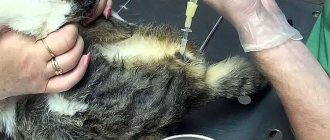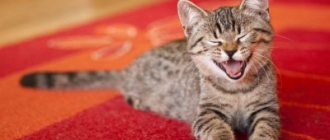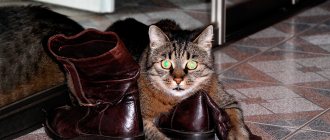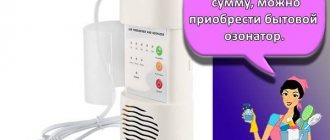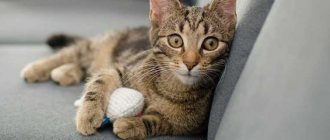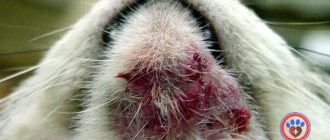Signs of incontinence
Symptoms of fecal incontinence in cats include:
- Insufficient ability of the large intestine to retain feces.
- Frequent urge to defecate. The animal often empties its intestines, and no fecal leakage is observed. False painful urges and pain during bowel movements may occur. Less commonly, bloody impurities are found in the stool.
- Increased sensitivity of the rectum, detected during endoscopic examination of the large intestine. The walls of the organ thicken, the mucous membranes thicken. The sphincter and muscle tissue of the anal area remain in normal condition. The anal reflex is not impaired.
- Presence of extensive perianal fistulas. It is observed with post-traumatic or infectious incontinence. The anal reflex is not impaired, but the outer muscle ring remains slightly open, especially if there is structural damage to the sphincter.
- Involuntary release of feces during physical activity. It is observed in diseases associated with impaired innervation of the rectum. The anal sphincter loses its tone, the reflex is weak or absent.
- Associated urinary incontinence. In combination with spontaneous defecation, it indicates disturbances in the functioning of the kitten’s nervous system.
- Loss of mobility and tone of the tail, pain in the lower spine, complete or partial paralysis of the limbs. Occurs when incontinence is caused by damage to the spinal cord. The muscles of the hind legs completely lose their tone, and there is no reaction to external stimuli.
Symptoms
There are several signs that can accurately determine that a cat is suffering from fecal incontinence.:
Punishment in such cases is useless and pointless; it will only aggravate stress, which will contribute to the deterioration of the pet’s condition and the progression of incontinence.
© shutterstock
Causes of the disease
The following reasons contribute to the occurrence of spontaneous bowel movements in cats:
- Decreased tone of the muscle walls of the large intestine.
- Diseases of the digestive system. Fecal incontinence is observed with colitis, irritable bowel syndrome, and the presence of malignant tumors.
- Diarrhea. When large volumes of feces are produced, the rectum loses its holding capacity, causing feces to leak.
- Injuries to the perianal area (scratches, abscesses, bites).
- Complications of surgical interventions. Incontinence occurs if the rectal wall or sphincter is damaged during surgery.
- Infectious diseases. Bacteria penetrate the fiber surrounding the rectum, causing fistulas to form through which feces are released.
- Nervous system disorders. Spontaneous defecation occurs with degenerative myelopathy, spinal cord damage, congenital defects (spinal deformity, spinal cord herniation), intervertebral hernia, trauma, inflammation of the spinal membranes. The innervation of the rectum can be disrupted when the arteries supplying the spinal cord are blocked by fibrous particles.
- Cauda equina syndrome. This term refers to a number of pathologies characterized by narrowing of the sacral part of the spinal canal. The nerve endings coming out of the spinal cord are compressed, which disrupts the functions of the rectum.
- Spondylosis. The disease is characterized by the appearance of bone growths on the vertebral plates.
- Pathological mobility of the lumbosacral spine.
- Bacterial or fungal infections of intervertebral cartilage and bone surfaces of the vertebrae.
- Benign and malignant tumors of the spinal cord.
- Neurological disorders associated with damage to the nerve endings of the perianal area. They occur against the background of infections or taking certain medications (for example, chemotherapy drugs).
- Dysfunction of the autonomic nervous system, neurological diseases of unknown origin.
- Muscular and neuromuscular pathologies.
- Aging of the body. It is accompanied by many pathological changes, for example, a decrease in the tone of the muscles responsible for controlling bowel movements, weakness of the anal sphincter, and impaired innervation.
Urinary and fecal incontinence in cats
Incontinence is not only a physical, but also a psychological problem for clean animals like cats. They bury their excrement very carefully and try to relieve themselves, large and small, away from where they sleep and eat.
Incontinence must be differentiated from simple bad manners or harmfulness of the animal, its desire to attract the attention of the owner. Or instincts that force a pet to mark territory.
Signs of incontinence
Incontinence in animals can be either urinary or fecal incontinent.
The main signs of incontinence are:
- the animal’s inability to restrain urination or defecation by force of will (the animal sleeps, then jumps up sharply, rushes to the tray, but does not have time to reach it, leaving a wet trail or feces on the way);
- leakage of urine or excretion of feces during the cat’s sleep, when he is engaged in play activities or eats tasty food;
- behavioral disorders (the cat becomes fearful, nervous or displays aggression).
Urinary incontinence is usually classified into several forms.
- Firstly, there is a slight leak or dripping. Urine is released in small portions almost constantly.
- Secondly, the constant leakage of urine. The liquid is not retained in the urine storage system, but flows out as it forms.
- Thirdly, this is an emergency form. In this form, the animal experiences an imperative urge to urinate and cannot hold urine, gets scared, meows, and urinates where it is standing or lying.
- Fourthly, the stress-dependent form. In this form, the animal urinates if it experiences strong emotions, both positive and negative.
If a cat with such a disease is scolded or otherwise punished, its stress will only worsen, and puddles will appear in inappropriate places more often.
Causes of incontinence
Cats may develop incontinence after the birth of their kittens. Postpartum incontinence is a disorder of the urinary system and usually occurs in a stress-related form. A cat cannot hold urine when coughing, physical activity, or when showing strong emotions. Restoration of function is possible within a year, but sometimes spontaneous recovery does not occur and the animal requires professional help.
Incontinence in older pets is associated with aging of the body and weakening of the sphincters, blocking access to the free passage of feces or urine.
Disorders of urination and defecation can be congenital; it is associated with abnormalities in the structure of the urinary organs.
Injuries to the lower parts of the spinal column and tail, surgical interventions in the pelvic area (including spaying and neutering operations) or the spine can cause urinary and fecal incontinence in an animal. With injuries to the spinal column, the animal often loses not only the ability to control bowel and bladder emptying, but also to move around using its hind limbs.
Pathologies of the spinal cord and brain structures in animals can cause the animal’s inability to control its natural needs.
Cancer can cause incontinence. Malignant tumors can disrupt the functioning of both the spinal cord and the urine storage and excretion system itself.
Diseases of internal organs affecting the urine output system (nephritis, urolithiasis) and endocrine pathologies (diabetes, obesity) can cause problems with urinary control. Infectious diseases can cause problems with the functioning of the animal's input organs.
If an animal is constantly exposed to stress, it may develop incontinence syndrome, which will subsequently be difficult to cope with.
Treatment
Treatment of this pathology can be medicinal and surgical.
Postnatal incontinence, defecation and urination problems caused by stress or injury can go away on their own without medication if favorable conditions are created for the cat. The cat should not be scolded in such a situation. We need to show her that she will not be kicked out of the house or punished. She is safe. Furniture should be covered with diapers.
With age-related changes in the muscular-ligamentous system in cats, treatment may be ineffective and the owner will have to put up with this unpleasant problem. If such a problem occurs, the animal should be shown to a specialist to determine the cause of incontinence and prescribe proper treatment.
nld.ru
Treatment of the disease
If your cat spontaneously passes bowel movements, the following will help to cope with the problem:
- Warm water enemas. The procedures help reduce the volume of feces accumulating in the large intestine. The number of cases of spontaneous fecal excretion is reduced.
- Calling reflex defecation. You can empty the intestines of a paralyzed animal by pinching the tail or toe of the hind paw.
- Antibacterial therapy. Effective for incontinence caused by deep infection. Cefazolin is administered intramuscularly, which is effective against a wide range of pathogens.
- Diets. Special foods help reduce the volume of feces. The cat needs to be fed on a schedule, this allows you to control bowel movements. Foods rich in fiber are excluded from the animal’s diet.
- Surgical interventions. Surgery on the anus increases the sphincter's ability to retain feces.
- Drug therapy. Opiate-based drugs affect intestinal motility. Contractile activity of the intestine decreases, the movement of feces slows down. Liquid from the stool is absorbed, causing its volume to decrease.
- Anti-inflammatory drugs (steroid hormones, sulfasalazine). Used to treat incontinence in cats suffering from inflammatory diseases of the digestive system.
Examination by a veterinarian
The doctor needs to tell all the symptoms that the owner noticed. During the examination, the veterinarian will perform palpation, which can be used to identify large tumors and organ development abnormalities.
In case of incontinence and other urological disorders, a urine test will be prescribed, most often microscopy of the sediment will be required. Previously, we have already given a detailed explanation of a urine test for a cat. If necessary, ultrasound and x-rays are also performed.
Additional studies may be needed, such as a blood test, microflora culture, and analysis of renal epithelium in the cat’s urine.
Important: obvious neurogenic disorders such as injuries, tumors, spinal hernias, and urinary disorders are treated by eliminating these factors.
In cases of functional disorders, a complete and comprehensive examination cannot be avoided. Only a complete collection of all indicators will make it possible to correctly diagnose and correctly prescribe treatment.
During the examination, the veterinarian will recommend using special diapers for animals. There should always be a clean, absorbent diaper on the sleeping area. These care items are sold at any pet store.
Important: do not scold your pet for its inability to tolerate, do not punish it under any circumstances. A stressful situation will only harm the animal, but affection and care, on the contrary, will help cope with the disease.
Prevention of incontinence
Prevention of fecal incontinence in cats involves proper feeding of the pet. Food should not cause constipation or diarrhea. If an animal suffers from a neurological disease, it must be examined regularly. Timely treatment of infections and injuries plays an important role in the prevention of incontinence.
All information posted on the site is provided in accordance with the User Agreement and is not a direct instruction to action. We strongly recommend that before using any product, you must obtain a face-to-face consultation at an accredited veterinary clinic.
Food poisoning
In case of food poisoning (eating low-quality spoiled foods or poisonous plants), the animal will vomit and diarrhea. The body thus tries to get rid of the product that has entered the intestines as quickly as possible, collecting water from the entire body in order to flush it along with the irritant into the toilet. The feces may be so liquid that the cat simply cannot hold it in.
We suggest you read: Pathology of polycystic ovary syndrome in cats, what may be the cause of development and treatment of formation
In case of food poisoning, the cat should be put on a starvation diet for a day. You can give a sorbent to quickly remove toxins. If the condition worsens or other symptoms appear, you need to go to the vet, because it may not be food poisoning, but an infection.
We get tested
It is better to take any tests in the morning on an empty stomach. The only exceptions are emergency cases, if the pet suddenly becomes ill and needs emergency hospitalization.
Donating blood is easy: the veterinary nurse will find a vein and take a portion of blood without any problems.
Many owners are concerned about the question of how to collect urine from a cat for analysis. To do this, prepare a tray: remove the filling, wash it, and pour boiling water over it. There is no need to use aggressive detergents such as bleach. Even if the pet doesn’t like the empty tray, sooner or later he will go into it. Drain the liquid into a jar and take it to the clinic.
If your pet does not have time to reach the tray, put a diaper on it. Later, squeeze the diaper into a jar for analysis. But this option is not very good, since the composition of the diaper can change the composition of the urine.
Another option: go to the clinic. To take the test, the doctor will insert a catheter. Catheterization is not very comfortable for the furry patient, but is completely painless. The most accurate and pure material is considered to be obtained by a-puncture of the bladder. The needle is inserted through the abdomen into the bladder, then the required amount of liquid is sucked out. The procedure is easily tolerated by animals; anesthesia or freezing is not required.
Stress
Mammals have a syndrome called bear disease. This is when the intestines relax due to nervousness. Cats and dogs are no exception. Any turn of events - a walk, moving, traveling, strangers in the house, rearranging furniture - can cause a storm of emotions and a relaxation of the stomach. Moreover, this effect is observed not only when experiences are negative, but also when they are positive. Excessive emotions are stressful in any case.
If there are no visible organic reasons for diarrhea, one can suspect the emotional nature of the symptom. In this case, it is worth calming the cat, caressing it and providing a calm environment. If the stress was caused by a one-time experience, after a while the animal will calm down and the diarrhea will go away. If the cause is chronic stress, which you cannot influence, you need to consult a veterinarian about the possibility of taking sedatives.
The human body is a reasonable and fairly balanced mechanism.
Among all infectious diseases known to science, infectious mononucleosis has a special place...
The world has known about the disease, which official medicine calls “angina pectoris,” for quite a long time.
Mumps (scientific name: mumps) is an infectious disease...
Hepatic colic is a typical manifestation of cholelithiasis.
Brain edema is a consequence of excessive stress on the body.
There are no people in the world who have never had ARVI (acute respiratory viral diseases)…
A healthy human body is able to absorb so many salts obtained from water and food...
Knee bursitis is a common disease among athletes...

